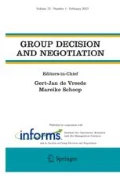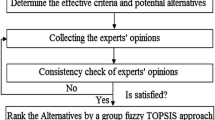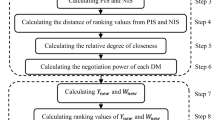Abstract
Group decision-making (i.e., multi-expert) is an important subject in planning water resources. The inherent complexity and uncertainty of real world urge many experts to be involved in decision-making processes. This paper presents an application of the linguistic-label aggregation method in a real-life case study. The case was taken from a foresight exercise in Colombia (South America) concerning environmental and water resources planning in a river basin. The group decision-making problem is solved using a four-step approach based on (i) the evaluation of experts’ opinions, (ii) the aggregation of opinions for each alternative, (iii) fuzzy ranking, and (iv) final assessment. Two main issues that are new in our work is that we consider temporal linguistic labels and a fuzzy ranking procedure that is able to include the mean, the standard deviation, the fuzzy membership function and the frequency of experts’ opinions for each alternative. The approach is developed and implemented on a computational tool. Results show an efficient decision-making process, that is, the tool demonstrated to deal with shortest time frames and to increase the efficiency of the planning resources, mainly because allows the decision manager to focus on the establishment of criteria. The latter also leads to objectivity and eases the identification and discussion of elements of consensus in decisions that otherwise may be embedded in individuals’ interests.
Similar content being viewed by others
References
Alavi M, Keen PG (1989) Business teams in an information age. Inf Soc 6(4): 179–195
Barbieri E, Medina J (2000) Scenarios as seen from human and social perspective. Technol Forecast Soc Change 65: 49–66
Barrera E, Escobar J (2003) A fuzzy approach for Delphi method (in Spanish). Ingeniería Desarrollo 14: 1–23
Ben-Arieh D, Chen Z (2006) Linguistic-labels aggregation and consensus measure for autocratic decision making using group recommendations. IEEE Trans Syst Man Cybern A Syst Hum 36(3): 558–568
Boclin ASC, de Mello R (2005) A decision support method for environmental impact assessment using fuzzy approach. Ecol Econ 58: 170–181
Carlsson C, Fuller R (2000a) Benchmarking and linguistic importance weighted aggregations. Fuzzy Sets Syst 114: 35–42
Carlsson C, Fuller R (2000b) Multiobjective linguistic optimization. Fuzzy Sets Syst 115: 5–10
Chang PT, Lee ES (1994) Ranking of fuzzy sets based on the concept of existence. Comput Math Appl 27: 1–21
Chen SJ, Chen SM (2005) Aggregating fuzzy opinions in the heterogeneous group decision-making environment. Cybern Syst 36: 309–338
Chen S, Hwang CL (1992) Fuzzy multiple attribute decision-making. Springer, New York
Degani R, Bortolan G (1988) The problem of linguistic approximation in clinical decision making. Int J Approx Reason 2(2): 143–162
Delgado M, Verdegay JL, Vila MA (1992) Linguistic decision making models. Int J Intell Syst 7: 479–492
Delgado M, Herrera F, Herrera-Viedma E, Martínez L (1998) Combining numerical and linguistic information in group decision. Inf Sci 107: 177–194
Hepting DH (2007) Decision support for local environmental impact assessment. Environ Modell Softw 22(4): 436–441
Herrera F, Herrera-Viedma E, Verdegay JL (1995) A sequential selection process in group decision making with a linguistic assessment-approach. Inf Sci 85: 223–239
Herrera F, Herrera-Viedma E, Verdegay JL (1996a) A model of consensus in group decision making under linguistic assessments. Fuzzy Sets Syst 78: 73–87
Herrera F, Herrera-Viedma E, Verdegay JL (1996b) Direct approach processes in group decision making under linguistic OWA operators. Fuzzy Sets Syst 79: 175–190
Herrera F, Herrera-Viedma E (1997) Aggregation operators for linguistic weighted information. IEEE Trans Syst Man Cybern A 27(5): 646–656
Herrera F, Herrera-Viedma E, Verdegay JL (1997) A rational consensus model in group decision making using linguistic assessments. Fuzzy Sets Syst 88: 31–49
Herrera F, Herrera-Viedma E, Verdegay JL (1998) Choice processes for non-homogeneous group decision making under linguistic setting. Fuzzy Sets Syst 94: 287–308
Herrera F, Herrera-Viedma E (2000a) Choice functions and mechanisms for linguistic preference relations. Eur J Oper Res 120: 144–161
Herrera F, Herrera-Viedma E (2000b) Linguistic decision analysis: steps for solving decision problems under linguistic information. Fuzzy Sets Syst 115: 67–82
Herrera F, Martínez L (2001) A model based on linguistic 2-tuples for dealing with multigranular hierarchical linguistic contexts in multi-expert decision-making. IEEE Trans Syst Man Cybern B 31: 227–234
Herrera F, Martínez L, Sánchez PJ (2005) Managing non-homogeneous information in group decision making. Eur J Oper Res 166: 115–132
Heske T, Heske JN (1999) Fuzzy logic for real world design. Annabooks. (ISBN:978-0929392240)
Hwang CL, Lin M (1987) Group decision making under multiple criteria: methods and applications. Springer, Berlin
Kacprzyk J (1986) Group decision making with a fuzzy linguistic majority. Fuzzy Sets Syst 18: 105–118
Karacapilidis N, Gordon T (1995) Dialectical planning. In: Proceedings of the 14th international joint conference on artificial intelligence. Montreal, pp 239–250
Landeta J (2006) Current validity of the Delphi method in social sciences. Technol Forecast Soc Change 73: 467–482
Lee ES, Li RJ (1988) Comparison of fuzzy numbers based on the probability measure of fuzzy events. Comput Math Appl 15: 887–896
Lee-Kwang H, Lee J (1999) Method for ranking fuzzy numbers and its application to decision-making. IEEE Trans Fuzzy Syst 7: 677–685
Liu KFR, Lai JH (2009) Decision-support for environmental impact assessment: A hybrid approach using fuzzy logic and fuzzy analytic network process. Expert Syst Appl 36(3): 5119–5136
Liu CM, Wang MJ, Pang YS (1994) A multiple criteria linguistic decision making model (MCLDM) for human decision making. Eur J Oper Res 76: 466–485
Peche R, Rodríguez E (2009) Environmental impact assessment procedure: a new approach based on fuzzy logic. Environ Impact Assess Rev 29(5): 275–283
Quinaxi (2004) Construcción participativa de los escenarios de prospección para el plan de ordenación de la Cuenca del río La Miel (project executed). http://www.quinaxi.org/proyectos/proyectos.shtml
Wang RC, Chu SJ (2004) Group decision-making using fuzzy linguistic approach for evaluating the flexibility of a manufacturing system. Eur J Oper Res 154: 563–572
Weinhardt C, Seifert S (2010) Developments in GDN research: introduction. Group Decis Negotiat 19(2): 107–109
Xu ZS (2004a) Uncertain multiple attribute decision making: methods and applications. Tsinghua University Press, Beijing
Xu ZS (2004b) A method based on linguistic aggregation operators for group decision making with linguistic preference relations. Inf Sci 166: 19–30
Xu ZS (2005) Deviation measures of linguistic preferences relations in group decision making. Omega 33: 249–254
Xu Z (2006) A practical procedure for group decision making under incomplete multiplicative linguistic preference relations. Group Decis Negotiat 15: 581–591
Yager RR (1984) On different classes of linguistic variables defined via fuzzy subsets. Kybernetes 13: 103–110
Yager RR (2004) On the retranslation process in Zadeh’s parading of computing with words. IEEE Trans Syst Man Cybern B 34: 1184–1195
Zadeh LA (1983) A computational approach for fuzzy quantifiers in natural languages. Comput Math Appl 9: 149–184
Zhang G, Lu J (2003) An integrated group decision-making method dealing with fuzzy preferences for alternatives and individual judgments for selection criteria. Group Decis Negotiat 12: 501–515
Author information
Authors and Affiliations
Corresponding author
Additional information
To Group Decision and Negotiation journal, special issue on “Group Decision and Negotiation in Latin America: Practice and Methodological Issues”.
Rights and permissions
About this article
Cite this article
Halabi, A.X., Montoya-Torres, J.R. & Obregón, N. A Case Study of Group Decision Method for Environmental Foresight and Water Resources Planning Using a Fuzzy Approach. Group Decis Negot 21, 205–232 (2012). https://doi.org/10.1007/s10726-011-9269-z
Published:
Issue Date:
DOI: https://doi.org/10.1007/s10726-011-9269-z




